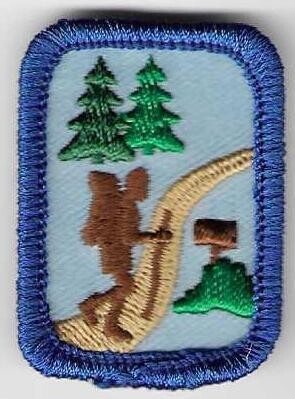Hiking, Patriot's Trail Council own IP (Remake)
Requirements:
This interest project patch follows the current format with Skill Builders (2 activities required including the two starred), Technology (1 activity required), Service Projects (1 activity required), and Career Exploration (1 activity required) plus two additional activities from any of the areas.
Helpful Resources: Outdoor Education in Girl Scouts, GSUSA Take a New Bearing, American Camping Association. For Cadette and Senior Girl Scouts.
Skill Builders
1. * Learn what to carry with you for a day hike. Learn why each item is important. Put together these essentials for use on a practice hike. Help plan and participate on at least three all day hikes. Learn minimal impact ethics and practice them in your hikes. Develop your hiking fitness by designing your practice hike and three day hikes so that they follow a physical progression. Develop and use a warm-up routine for beginning your hikes. See pages 150-158, Outdoor Education in Girl Scouting. See Chapter 3, "On Your Way", Take a New Bearing.
2. * For your group, develop hiking guidelines that integrate group safety considerations, minimal impact ethics and individual physical differences (for example: stamina, pace). After each hike, evaluate your guidelines and, if necessary, adjust them to make them more effective for your group. See Chapter 5, "Staying Safe", Outdoor Education in Girl Scouting.
3. Learn about trail nutrition. What foods are particularly important? Which foods pack easier? How much water should you carry? Plan and put together a nutritional, well-balanced meal that requires no cooking and no refrigeration for your next hike. Be sure to include some emergency rations.
4. Know how to give first aid for the following conditions: scrapes, cuts, sprains, sunburn, blisters, tick bites, insect stings, hypothermia, frostbite, heat exhaustion, heatstroke, burns and contact with poisonous plants and animals indigenous to your area. Assemble a small hiker first aid kit and carry it with you when you hike. See pages 83-94, Outdoor Education in Girl Scouting.
5. Learn how to use a topographical map and compass. Use these skills on one of your hikes to navigate the terrain.
Technology
1. Compare different types of hiking boots. Determine what you need to consider when choosing hiking boots including expected usage and materials. Also investigate what socks to wear. Visit a website that shows the differences, talk with a knowledgeable retailer, or find the information in an outdoor magazine or catalog.
2. Visit a sporting goods store that specializes in outdoor equipment. Learn about different types of backpacks and daypacks and the advantages and disadvantages of each. Choose an appropriate pack for one of the hikes you have planned and try it on, adjusting it to fit you.
3. Learn how to dress appropriately for a day of hiking. Include provisions for changeable weather and problems that might occur, such as a tick-infested area. Compare different fabrics and know how to "layer." See pages 32-34, Outdoor Education in Girl Scouting.
4. Learn about different methods of water purification and what is appropriate for your area. What are the scientific principles at work in each method? Make a chart comparing the advantages and disadvantages (including cost) of the different methods. See pages 36-37, Outdoor Education in Girl Scouting
Service Projects
1. Participate in a trail clean-up day for a local trail. Advertise your clean-up day to others using flyers, posters or some other method.
2. For your council or another organization, help create a new trail or make improvements to an existing one. Learn the proper methods to cut and clear unwanted growth, and for erosion control.
3. Help Junior Girl Scouts earn their Hiker Badge.
4. Plan and conduct an outdoor fashion show detailing different clothing, equipment, and footwear for a group of younger girls.
5. Design and carry out an activity to teach others about minimal impact ethics.
Career Exploration
1. Brainstorm careers involving hiking and the out-of-doors and develop a list of 5-8. Include a brief description of each. Interview or read about someone in one of these careers and find out about what her work entails.
2. Interview someone that works for the Sierra Club or another outdoor recreational club. Find out what opportunities are available and what training and education are necessary.
3. Find out about job opportunities in outdoor equipment retail sales. Find out about the skills, education, and experience necessary for different types of jobs.
4. Interview someone whose job includes teaching minimal impact ethics. Find out about her skills, education and background. How has this information changed over the years? How does she keep up-to-date?
5. The outdoors can be used as a setting for teambuilding and personal growth. Find out more about such a program that includes a hiking component. Interview a program facilitator. Find out about her training, education and background. What individuals, groups and organizations participate in the program? Find out more about the group dynamics that the facilitator has observed in her work, especially those relating to hiking.
